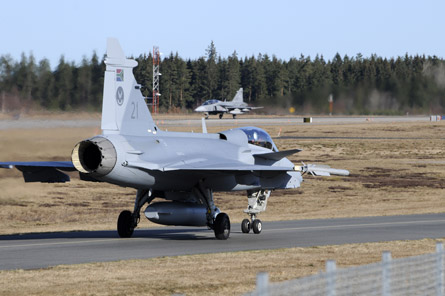The modern South African Air Force (SAAF) is a very different organisation from the apartheid era, whites-only service that preceded it. Since 1994, South Africa has had a democratic government and an entirely different outlook on regional security issues, with the focus changed from border defence to a wider role in peace-keeping and other interventions on the continent.
With those monumental changes come entirely new requirements. After it was elected, the ANC government drastically shrank the size and scope of the country's military forces, with the SAAF no exception. But despite the reduction in size, the SAAF remains sub-Saharan Africa's best equipped and most effective air force. Part of the reason is that the government has worked diligently to modernise the country's aircraft fleet.
 |
|---|
Saab The SAAF's last four of 26 Saab Gripens are due to be handed over in September |
The SAAF is acquiring a force of 26 Swedish-built Saab Gripen C and D model fighters, the last four of which are due to be handed over this month. The Gripen has replaced the Dassault Mirage III-derived indigenous Atlas Cheetah C and D fighters, but because of financial constraints, the SAAF has been unable to fully utilise its new aircraft. Pilots are simply not getting the hours they need to maintain their proficiency in the Gripen, but efforts are under way to try to rectify that.
FLIGHT TRAINING
Maj Gen Tsoku Khumalo, the SAAF's director of force preparation, told South African reporters in April that the service hopes to increase pilot flight hours to 180 per year. "You can't sacrifice the hours you need to maintain currency," he said. But the SAAF has the equipment it needs to train new pilots. Basic flight training is conducted on the Pilatus PC-7 Mk II, which were introduced in 1994. Of the 60 aircraft originally bought, 35 were slated to be upgraded in 2008. The first modified aircraft was delivered in July 2010. Deliveries are set to continue at one per month until March 2013.
For advanced pilot training, the country operates a fleet of 24 BAE Systems Hawk 120 jet trainers, the first of which were delivered in March 2006. The aircraft are used as a bridge to the Gripen using its embedded simulation software. Even though the aircraft are relatively new, further modifications could be on the way to increase the level of Gripen emulation the Hawk provides.
For advanced graduate-level fighter training, Saab announced in July at the Farnborough air show it would set up a new Gripen Fighter Weapons School at Overberg air base using six SAAF Gripens. "The Gripen Fighter Weapon School will hone the fighting skills of experienced Gripen pilots from all over the world," the company said. As many as six nations were to have participated, but within days the SAAF denied all knowledge of a proposed Gripen weapons school.
"The Air Force Base Overberg is a sensitive security establishment of the SANDF [South African National Defence Force] and will remain solely in the hands of the SANDF. The suggestion, therefore, that such a school will be established is devoid of truth," the SAAF says.
On the airlift side, the SAAF planned to purchase the Airbus Military A400M for its strategic requirements. However, after that programme was delayed and costs increased, South Africa cancelled its order in late 2009.
DEAL DENIAL
Recently, media reports suggested the deal had been resurrected; but Airbus and local programme partner Denel both deny that is the case. "The suggestion of a revised deal appears to have arisen as a result of an incorrect media report in July," Airbus says. But that still leaves South Africa needing to replace its antiquated fleet of eight Lockheed Martin C-130B Hercules. Alenia Aermacchi has expressed interest in pitching its C-27J Spartan for the role, while Airbus Military is proposing the C295. Airbus has recently been on tour in South Africa with the C295 as part of its sales efforts.
But Lockheed has also entered the fray with new J-model versions of the Hercules. "We will actually be pitching both the C-130XJ and the multi-mission capability," Lockheed says. "South Africa has a bunch of requirements they need to fill and the J will make the best baseline platform for those missions."
Surveillance versions of all three aircraft could also fill South Africa's urgent need to replace its 12 ancient Douglas DC-3s in the maritime patrol mission, known as Project Saucepan, the companies say. The country's extensive coastline spans a major shipping route and the DC-3s counter everything from piracy and smuggling to illegal fishing, as well as any military threat - all priorities for Pretoria.
Source: Flight International
















